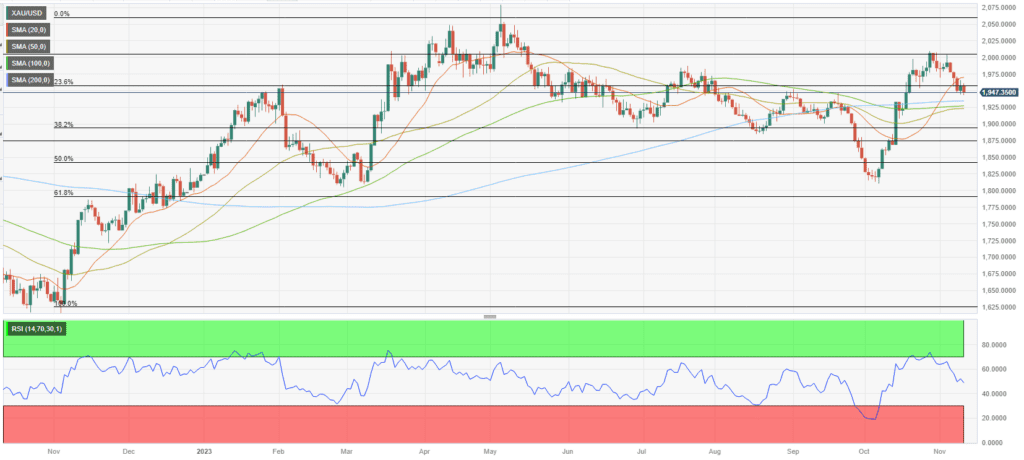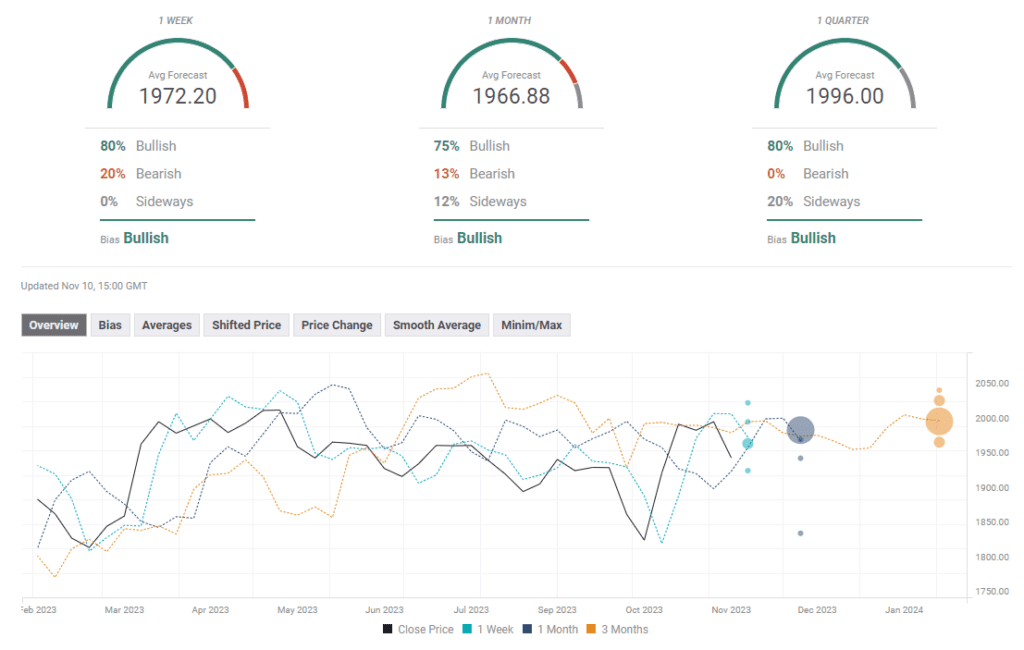In this week’s Gold Price Weekly Forecast, we delve into the factors that are likely to influence the precious metal market, analyze the potential impact of the US October inflation data, and provide insights into the gold technical outlook. As we navigate the complexities of the global economy, understanding these key aspects is vital for both seasoned and novice investors in the gold market.
Factors Influencing Gold Prices
Before we delve into the upcoming events and technical indicators that will define the gold price weekly forecast, it’s essential to thoroughly examine the multifaceted factors that have exerted their influence on the price of gold in recent times. Gold, often referred to as the “safe-haven” asset, has a unique sensitivity to global economic, political, and financial developments. Here’s a deeper dive into the factors that have been instrumental in shaping the current dynamics of the gold market:
- Uninspiring Chinese Data: China, as the world’s largest consumer of gold, plays a pivotal role in influencing the precious metal’s price. Economic data coming out of China, especially indicators related to its growth, trade surplus, and consumer activity, are closely monitored by the global financial community. In recent times, Chinese economic data has been less than inspiring, contributing to the cautious sentiment in the gold market. A weaker Chinese economy can reduce demand for gold, as it reflects broader economic uncertainty.
- Geopolitical Tensions: The ebb and flow of geopolitical tensions have a profound impact on gold prices. Gold has historically been sought after as a safe haven during times of international crises, conflicts, and uncertainty. In recent weeks, there has been a gradual easing of some geopolitical tensions, particularly in regions that were previously sources of concern. This reduction in geopolitical risk has partially tempered the demand for gold as a hedge against instability. However, it’s essential to note that geopolitical developments can change rapidly, and gold remains a reliable asset for investors seeking refuge during periods of uncertainty.
- Monetary Policy and Interest Rates: The policies of central banks, particularly the Federal Reserve in the United States, have a direct bearing on gold prices. Gold is inversely correlated with interest rates; when interest rates are low, the opportunity cost of holding non-yielding gold is reduced, making it more attractive to investors. Conversely, when interest rates rise, gold may become less appealing compared to interest-bearing assets. Therefore, the outlook for monetary policy and interest rates can significantly impact gold prices. The gold market often responds to statements and actions taken by central bank officials.
- Currency Movements: Gold is traded internationally, and its price is denominated in various currencies. Exchange rate fluctuations can influence gold prices. A weaker US Dollar, for instance, can make gold more affordable for international buyers and tend to push its price higher. Conversely, a stronger dollar can have the opposite effect. Gold often serves as a hedge against currency devaluation and can see increased demand when currencies are under pressure.
- Market Sentiment and Risk Appetite: Investor sentiment and risk appetite also play a role in determining gold prices. During times of economic optimism and bullish stock markets, investors may allocate fewer resources to gold. However, when sentiment turns bearish, or there are concerns about market volatility, gold often shines as a haven asset. The overall perception of risk in the financial markets can influence the demand for gold as a portfolio diversifier and safe-haven asset.
Understanding these multifaceted factors is essential for investors and traders as they navigate the gold market. The interplay between these elements creates a complex and dynamic landscape for gold pricing, making it imperative to stay attuned to global developments and their potential impact on the precious metal’s value. In the next sections, we’ll delve deeper into specific events and technical indicators that will shape the gold price weekly forecast.
Gold Price Weekly Forecast: US October Inflation Data
One of the most eagerly awaited events on the economic calendar is the release of the US October inflation data. This data point has the potential to significantly influence the direction of gold prices in the coming week. As we assess the prospects for gold, understanding the implications of this data is paramount.
Investors and analysts are closely monitoring the Consumer Price Index (CPI) for October, which is forecasted to rise by 0.1% on a monthly basis. Additionally, the Core CPI, which excludes volatile food and energy prices, is expected to increase by 0.3%. These numbers will be closely scrutinized, as they could set the tone for the broader market sentiment.
The CME Group FedWatch Tool currently shows that markets are pricing in a 90% probability that the Federal Reserve (Fed) will leave the policy rate unchanged at 5.25%-5.5% in December. This positioning suggests that any deviation from the expected inflation readings could lead to a significant market reaction.
In the event of a stronger-than-forecast inflation reading, the market may reassess its outlook on interest rates, potentially bolstering the US Dollar (USD). Should this scenario unfold, we could witness upward pressure on the 10-year US yield, which, in turn, may cause gold (XAU/USD) to extend its slide. However, the opposite holds true for a weaker-than-expected Core CPI print, which may dampen the demand for USD, making it challenging for gold to gather bullish momentum, unless geopolitical tensions resurge.

Gold Technical Outlook
Turning our attention to the technical aspects of gold, let’s examine the gold technical outlook. The Relative Strength Index (RSI) indicator on the daily chart retreated to 50, reflecting a loss of bullish momentum in XAU/USD. This suggests that investors are currently taking a cautious approach.

Significant support appears to have formed in the range of $1,925 to $1,930, where the 200-day Simple Moving Average (SMA), 100-day SMA, and the 50-day SMA converge. If gold falls below this area and starts using it as resistance, the next bearish target could be the psychological level of $1,900, followed by the Fibonacci 38.2% retracement level of the long-term uptrend at $1,875.
On the upside, immediate resistance is seen at $1,960, which aligns with the Fibonacci 23.6% retracement level. A daily close above this level could attract buyers and open the door for an extended rebound toward $2,000, a psychological and static resistance level that has drawn significant attention from investors.

Precious Metal Market Analysis
To gain a deeper understanding of the gold market’s dynamics, it is essential to engage in precious metal market analysis. This comprehensive analysis involves evaluating various economic factors, geopolitical events, and central bank policies that influence the value of precious metals like gold.
The recent fluctuations in gold prices have been driven not only by domestic factors but also by global events and monetary policies. This underscores the interconnectedness of the precious metal market with the broader financial landscape.
Federal Reserve Policy Impact
The Federal Reserve’s policies play a pivotal role in shaping the performance of precious metals, including gold. Fed Chairman Jerome Powell’s statements and the central bank’s approach to policy decisions are closely monitored by investors. Powell’s recent remarks emphasized the Fed’s data-dependent approach to policy, making decisions based on incoming data and their implications for economic activity and inflation.
While Powell noted the central bank’s commitment to data-driven decision-making, he expressed uncertainty about achieving a “sufficiently restrictive” policy stance to bring inflation down to the 2% target over time. This comment had a notable impact on the market, triggering a rally in US bond yields and influencing gold’s weekly performance.
Conclusion
In conclusion, as we anticipate the release of the US October inflation data and closely monitor the gold technical outlook, there is a sense of cautious optimism among bullish gold investors. The market is poised for potential shifts in response to economic data, central bank policies, and global events.
The precious metal market analysis underscores the importance of staying informed and agile in navigating the dynamic world of gold trading. Federal Reserve policy impact serves as a reminder of the critical role that central banks play in influencing the performance of precious metals.
As we embark on the upcoming week, gold investors will need to adapt to changing market conditions while keeping a keen eye on support and resistance levels. The gold price weekly forecast remains a crucial tool for investors seeking to make informed decisions in this ever-evolving landscape.
Click here to read our latest article on




